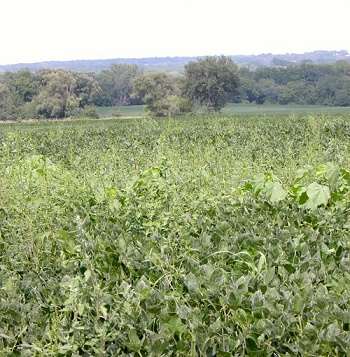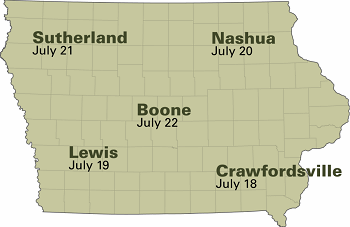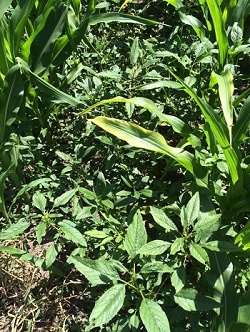By Meaghan Anderson
Most herbicide applications have ceased for the year, but it is not too late to evaluate how well the program worked and what changes might be necessary for next year. Rather than just falling back on old habits, analyze your program closely to look for improvements for future years.
Surviving weeds from this year will affect weed pressure in next year’s crops. Identifying this season’s management successes and failures will make weed management and herbicide purchase decisions easier this winter.
July is not a comfortable time to walk corn fields, but it is easy to check for weed survivors while scouting for disease or insect problems. Scanning above the soybean canopy for weeds is a much simpler task. Waterhemp and other weeds may continue to emerge above the soybean canopy into August and September.
Identify weeds correctly
When evaluating weed control, the first step is to properly identify the escapes. If you cannot identify the weed using resources you have, please contact another resource like a local Iowa State University Extension & Outreach field agronomist.

Try to determine why the weed survived your management program. Weeds can survive herbicides by avoiding exposure to the herbicide:
- weeds may avoid preemergence herbicides by emerging after the herbicide has degraded to non-toxic concentrations due to low application rate, early application, or excessive rainfall following application,
- weeds may avoid postermergence herbicides by germinating after postemergence applications.
Weeds that are exposed to the herbicide can survive a herbicide application for any number of reasons, and determining why it is important to avoid repeat problems. The main factors influencing the activity of preemergence herbicides are soil type and rainfall. Was the application rate appropriate for the soil type, or was rainfall adequate to activate the herbicide and make it available in the weed seed germination zone?
Postemergence herbicides are influenced by many factors, including weed size, environmental conditions, spray additives, and spray coverage. Spraying weeds that exceed the maximum size specified on the herbicide label is probably the number one cause of postemergence herbicide failures.
Finally, weeds may survive due to the presence of herbicide resistance within the field. When resistance is just beginning to evolve within a field, escapes are usually found in discrete patches, and it is often possible to find surviving plants immediately adjacent to dead individuals of the same species.
The final step is to use this information to make decisions for next year. Surviving weeds may warrant a change in product or herbicide site of action, increased herbicide application rates, or use of a more innovative approach, like a layered residual program.
Is it too late for waterhemp this year?
When soybeans enter reproductive stages, herbicide treatment options for waterhemp control are limited to the Group 14 products. Fomesafen labels do not allow for treatment after soybeans reach stage R2 (full flower), but lactofen and aciflourfen are labeled for later season sprays. Always check herbicide labels for specific information. These products are labeled to control up to 2-3 inch waterhemp, and when herbicides are applied to larger-than-labeled weeds, the company is not responsible for the results.
Very little information is available on the effect of late treatments on control or reduction in seed production. Carefully evaluate whether the risk and expense of these treatments will justify the benefit. Dr. Hartzler has written articles in the past about these late sprays including “Controlling large weeds – Do you feel lucky?” and “Late season herbicide applications in soybeans”.
Weeds Week 2016
Interested in learning more about improving your weed management skills or managing for herbicide resistant weeds?

Unsure of the next step to improve your weed management? Are weeds taking over?
Weeds Week is an educational program for farmers and retailers that focuses on herbicide resistant weeds and creating a long-term weed management plan that will work for you. Each session will combine presentations, group discussion, field demonstrations, and hands-on planning to understand herbicide program development and management for the long-term. Farmers and retailers will leave this meeting with a better knowledge of herbicide resistance development and herbicide group identification. They will also learn valuable methods to evaluate herbicide programs for effectiveness.
A registration fee of $25 will include lunch, refreshments, and all handouts and publications. Registration begins at 9:30 a.m. each day and the program will end at approximately 3:00 p.m. It qualifies for 4.0 pest management Iowa Certified Crop Advisor continuing education credits.
Choose one of five locations to attend: Crawfordsville on July 18; Lewis on July 19; Nashua on July 20; Sutherland on July 21; or Boone on July 22. For more information on this program, contact your local Iowa State University Extension & Outreach field agronomist or register online at www.aep.iastate.edu/weeds.

Waterhemp survived herbicide applications to compete with this corn crop. What changes are necessary for next year as a result of these surviving weeds?
Photo by Meaghan Anderson
Source:iastate.edu